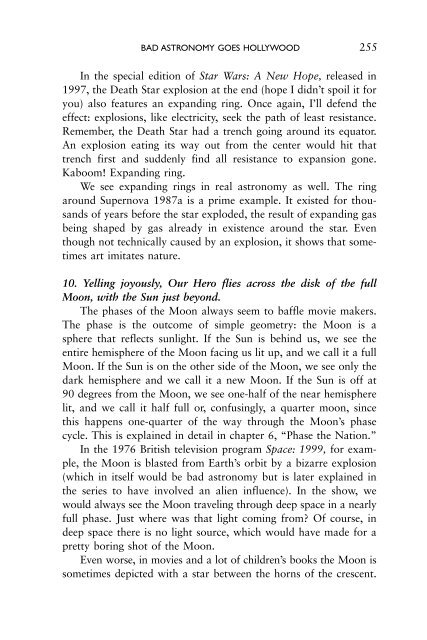Bad Astronomy: Misconceptions and Misuses Revealed, from ...
Bad Astronomy: Misconceptions and Misuses Revealed, from ...
Bad Astronomy: Misconceptions and Misuses Revealed, from ...
You also want an ePaper? Increase the reach of your titles
YUMPU automatically turns print PDFs into web optimized ePapers that Google loves.
BAD ASTRONOMY GOES HOLLYWOOD 255<br />
In the special edition of Star Wars: A New Hope, released in<br />
1997, the Death Star explosion at the end (hope I didn’t spoil it for<br />
you) also features an exp<strong>and</strong>ing ring. Once again, I’ll defend the<br />
effect: explosions, like electricity, seek the path of least resistance.<br />
Remember, the Death Star had a trench going around its equator.<br />
An explosion eating its way out <strong>from</strong> the center would hit that<br />
trench first <strong>and</strong> suddenly find all resistance to expansion gone.<br />
Kaboom! Exp<strong>and</strong>ing ring.<br />
We see exp<strong>and</strong>ing rings in real astronomy as well. The ring<br />
around Supernova 1987a is a prime example. It existed for thous<strong>and</strong>s<br />
of years before the star exploded, the result of exp<strong>and</strong>ing gas<br />
being shaped by gas already in existence around the star. Even<br />
though not technically caused by an explosion, it shows that sometimes<br />
art imitates nature.<br />
10. Yelling joyously, Our Hero flies across the disk of the full<br />
Moon, with the Sun just beyond.<br />
The phases of the Moon always seem to baffle movie makers.<br />
The phase is the outcome of simple geometry: the Moon is a<br />
sphere that reflects sunlight. If the Sun is behind us, we see the<br />
entire hemisphere of the Moon facing us lit up, <strong>and</strong> we call it a full<br />
Moon. If the Sun is on the other side of the Moon, we see only the<br />
dark hemisphere <strong>and</strong> we call it a new Moon. If the Sun is off at<br />
90 degrees <strong>from</strong> the Moon, we see one-half of the near hemisphere<br />
lit, <strong>and</strong> we call it half full or, confusingly, a quarter moon, since<br />
this happens one-quarter of the way through the Moon’s phase<br />
cycle. This is explained in detail in chapter 6, “Phase the Nation.”<br />
In the 1976 British television program Space: 1999, for example,<br />
the Moon is blasted <strong>from</strong> Earth’s orbit by a bizarre explosion<br />
(which in itself would be bad astronomy but is later explained in<br />
the series to have involved an alien influence). In the show, we<br />
would always see the Moon traveling through deep space in a nearly<br />
full phase. Just where was that light coming <strong>from</strong>? Of course, in<br />
deep space there is no light source, which would have made for a<br />
pretty boring shot of the Moon.<br />
Even worse, in movies <strong>and</strong> a lot of children’s books the Moon is<br />
sometimes depicted with a star between the horns of the crescent.
















